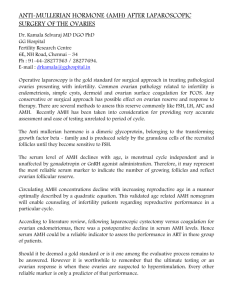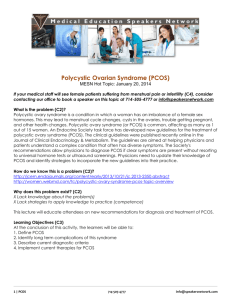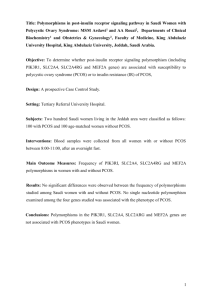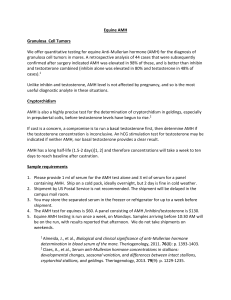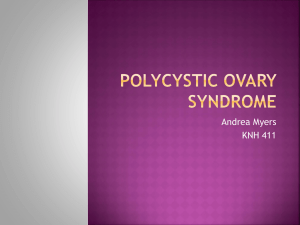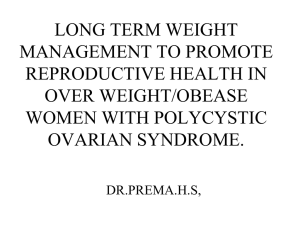Lack of Serum Anti-Mullerian Hormone Responses After Recombinant Human Chorionic Gonadotropin
advertisement
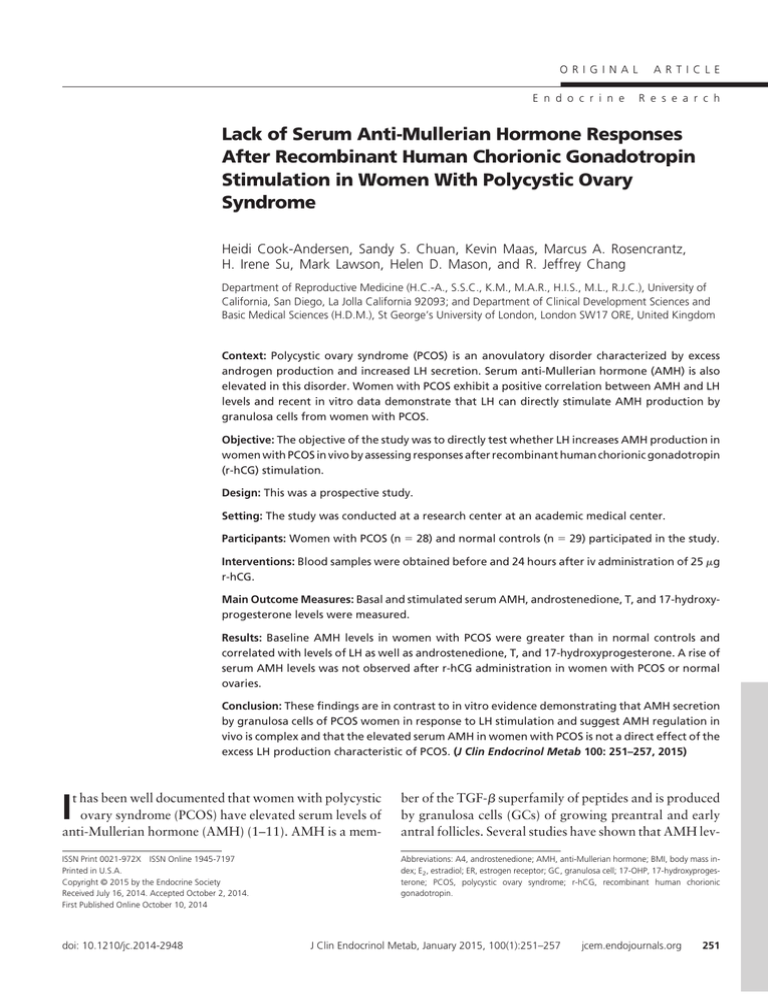
ORIGINAL E n d o c r i n e ARTICLE R e s e a r c h Lack of Serum Anti-Mullerian Hormone Responses After Recombinant Human Chorionic Gonadotropin Stimulation in Women With Polycystic Ovary Syndrome Heidi Cook-Andersen, Sandy S. Chuan, Kevin Maas, Marcus A. Rosencrantz, H. Irene Su, Mark Lawson, Helen D. Mason, and R. Jeffrey Chang Department of Reproductive Medicine (H.C.-A., S.S.C., K.M., M.A.R., H.I.S., M.L., R.J.C.), University of California, San Diego, La Jolla California 92093; and Department of Clinical Development Sciences and Basic Medical Sciences (H.D.M.), St George’s University of London, London SW17 ORE, United Kingdom Context: Polycystic ovary syndrome (PCOS) is an anovulatory disorder characterized by excess androgen production and increased LH secretion. Serum anti-Mullerian hormone (AMH) is also elevated in this disorder. Women with PCOS exhibit a positive correlation between AMH and LH levels and recent in vitro data demonstrate that LH can directly stimulate AMH production by granulosa cells from women with PCOS. Objective: The objective of the study was to directly test whether LH increases AMH production in women with PCOS in vivo by assessing responses after recombinant human chorionic gonadotropin (r-hCG) stimulation. Design: This was a prospective study. Setting: The study was conducted at a research center at an academic medical center. Participants: Women with PCOS (n ⫽ 28) and normal controls (n ⫽ 29) participated in the study. Interventions: Blood samples were obtained before and 24 hours after iv administration of 25 g r-hCG. Main Outcome Measures: Basal and stimulated serum AMH, androstenedione, T, and 17-hydroxyprogesterone levels were measured. Results: Baseline AMH levels in women with PCOS were greater than in normal controls and correlated with levels of LH as well as androstenedione, T, and 17-hydroxyprogesterone. A rise of serum AMH levels was not observed after r-hCG administration in women with PCOS or normal ovaries. Conclusion: These findings are in contrast to in vitro evidence demonstrating that AMH secretion by granulosa cells of PCOS women in response to LH stimulation and suggest AMH regulation in vivo is complex and that the elevated serum AMH in women with PCOS is not a direct effect of the excess LH production characteristic of PCOS. (J Clin Endocrinol Metab 100: 251–257, 2015) I t has been well documented that women with polycystic ovary syndrome (PCOS) have elevated serum levels of anti-Mullerian hormone (AMH) (1–11). AMH is a mem- ber of the TGF- superfamily of peptides and is produced by granulosa cells (GCs) of growing preantral and early antral follicles. Several studies have shown that AMH lev- ISSN Print 0021-972X ISSN Online 1945-7197 Printed in U.S.A. Copyright © 2015 by the Endocrine Society Received July 16, 2014. Accepted October 2, 2014. First Published Online October 10, 2014 Abbreviations: A4, androstenedione; AMH, anti-Mullerian hormone; BMI, body mass index; E2, estradiol; ER, estrogen receptor; GC, granulosa cell; 17-OHP, 17-hydroxyprogesterone; PCOS, polycystic ovary syndrome; r-hCG, recombinant human chorionic gonadotropin. doi: 10.1210/jc.2014-2948 J Clin Endocrinol Metab, January 2015, 100(1):251–257 jcem.endojournals.org 251 252 Cook-Andersen et al AMH Response to hCG in Women With PCOS els are strongly correlated with antral follicle number. Accordingly, increased circulating AMH in women with PCOS has generally been attributed to high antral follicle numbers associated with this disorder. Despite these observations, the precise mechanism of increased AMH production in women with PCOS remains unknown. AMH levels in women with PCOS have generally been found to correlate positively with circulating androstenedione (A4) and T levels and anovulation and negatively with serum FSH and body mass index (BMI) (4, 7, 9, 10, 12–18), although a few studies have not found these associations (17, 19, 20). In addition, studies evaluating the effects of FSH, androgens, or insulin on AMH levels have had either negative or inconsistent findings (2, 3, 9, 16, 20 –23). Recently, however, a large amount of accumulating data, both in vitro and in vivo, strongly suggests that LH acts to stimulate AMH production. Direct LH stimulation of GCs isolated from antral follicles from unstimulated ovaries from women with PCOS resulted in a 4-fold increase in AMH production by the GCs; no significant increase was seen from GCs from normal ovaries (22). Similar increases in AMH expression were also seen after in vitro LH stimulation of luteinized GCs from oligo/anovulatory women with PCOS but again not from GCs from normal ovaries (21, 24). In addition, a close examination of the circadian variation in hormone production in PCOS and normal women revealed a significant positive covariation between AMH and LH levels (but not other hormone measures) and that the circadian secretion of AMH and LH was linked, with a failure of LH and AMH levels to drop overnight in women with PCOS as observed in controls (25). Many other studies have also demonstrated a positive correlation between serum AMH levels and LH levels in women with PCOS (2, 15, 17, 20, 26, 27), although this correlation was not found in some studies (8, 9). Despite the strong in vitro evidence that LH stimulates AMH production and the associative correlations that link these hormones, the possibility of a direct causal effect of LH on AMH production has not been directly tested in women with PCOS. In the current study, we sought to determine whether LH stimulation of AMH production, as clearly observed in vitro, can also be detected in vivo by assessing serum AMH and androgen responses to recombinant human chorionic gonadotropin (r-hCG) stimulation in women with PCOS and normal women. Subjects and Methods Participants Twenty-eight women with PCOS and 29 normal women were recruited. PCOS subjects exhibited clinical and/or biochemical J Clin Endocrinol Metab, January 2015, 100(1):251–257 evidence of hyperandrogenism and were either oligomenorrheic or amenorrheic. Oligomenorrhea was defined as irregular menstrual bleeding occurring less than six times a year. Each PCOS subject had an antral follicle count per ovary of greater than 12, with no follicle that exceeded 9 mm in diameter and the vast majority being 2–5 mm in size. Normal women also had no follicles greater than 10 mm in diameter. Three-dimensional ultrasonography was performed for a subset of the subjects (12 PCOS and 10 controls) before beginning the study to obtain a more accurate antral follicle count than is possible with twodimensional ultrasound for the calculation of AMH levels per antral follicle. Late-onset congenital adrenal hyperplasia was excluded by serum 17-hydroxyprogesterone (17-OHP) less than 2 ng/mL. Circulating TSH, prolactin, FSH, and estradiol (E2) were normal among all subjects. No subject had received hormone medication for 2 months before the study. The study was approved by the Human Research Protection Program at the University of California, San Diego, and written informed consent was obtained from each participant. Procedures Subjects were admitted to the Clinical and Translational Research Institute at the University of California, San Diego, on each day of testing. Each subject received r-hCG as an iv bolus at a dose of 25 g as previously published (28). In normal subjects, r-hCG was given during the midfollicular phase (cycle days 5–9). In PCOS women, r-hCG was administered on a random day. Blood samples were obtained prior to and 24 hours after r-hCG administration. For a subset of the same and new PCOS (n ⫽ 8) and normal (n ⫽ 11) subjects, we subsequently evaluated AMH responses to a higher dose of 250 g of r-hCG iv administered in an identical fashion but with blood samples obtained prior to stimulation as well as at both 24 and 48 hours after stimulation. Two additional PCOS patients and two normal controls received r-hCG as an iv bolus at a dose of 25 g, with bloods samples obtained at time ⫽ 0, 2, 4, 8, 12, and 20 hours after hCG administration. For all studies, none of the PCOS subjects had experienced recent ovulation as evidenced by the absence of menstrual bleeding for 2 months before the study and serum progesterone less than 2.0 ng/mL. Assays Serum concentrations of LH and FSH were measured by a RIA with inter- and intraassay coefficients of variation of less than 4% for LH and less than 5% for FSH (Diagnostic Products Corp). Serum concentrations of E2, A4, 17-OHP, and T were measured by well-established RIA assays using column chromatographic separation in assays as previously published (3, 18, 28, 29) with inter- and intraassay coefficients of variation less than 7%. Serum AMH was measured by an ELISA (Beckman Coulter) with inter- and intraassay coefficients of variation less than 4%. Statistical analysis Descriptive statistics were calculated by means, medians, and proportions. Hormone values that were not normally distributed were log transformed. If data remained skewed, nonparametric tests were used. Baseline characteristics and circulating hormone levels were compared between women with PCOS and normal controls using the Student’s t test or Wilcoxon rank sum test, as appropriate. Paired data were compared by the paired t test or doi: 10.1210/jc.2014-2948 jcem.endojournals.org Serum AMH (ng/ml) Results Baseline hormone levels and antral follicle counts in women with PCOS and normal controls Baseline characteristics and circulating hormone levels for each group are shown in Table 1. Women with PCOS and normal controls did not differ significantly in age. As expected, women with PCOS had higher baseline levels of serum LH, T, A4, and 17-OHP as well as a higher BMI and baseline antral follicle count than normal controls. Serum FSH and E2 were similar between groups. Consistent with recent studies, mean baseline serum AMH levels were 2-fold higher in women with PCOS than normal controls, as shown in Figure 1A (9.6 ⫾ 1.2 ng/mL PCOS vs 4.1 ⫾ 0.6 ng/mL controls). No significant difference was detected in the circulating levels of AMH per antral follicle in women with PCOS (0.21 ⫾ 0.02 ng/mL) compared with normal controls (0.19 ⫾ 0.03 ng/mL) (Figure 1B; P ⫽ .62). As shown in Figure 2, there was a highly positive correlation between AMH and LH, whereas AMH and BMI were negatively correlated in women with PCOS. These correlations were not present in normal controls. In contrast, AMH was negatively correlated with age in normal controls, but this association was not observed in women with PCOS. Serum AMH was positively correlated with the ovarian androgens T and A4 in both groups, whereas there was no correlation with 17-OHP (controls: r ⫽ 0.30, Table 1. Baseline Characteristics and Hormone Concentrations of Women With PCOS and Normal Controls Age, y BMI, kg/m2 LH, mIU/mL A4, ng/mL T, ng/mL 17-OHP, ng/mL FSH, mIU/mL E2, pg/mL 2- to 9-mm folliclesb Controls (n ⴝ 29) PCOS (n ⴝ 28) 27.5 ⫾ 1.1 27.2 ⫾ 1.5 3.7 ⫾ 0.4 3.3 ⫾ 0.2 0.8 ⫾ 0.1 1.0 ⫾ 0.2 6.6 ⫾ 0.4 52.5 ⫾ 5.5 13.6 ⫾ 1.5 26.7 ⫾ 0.8 32.3 ⫾ 1.3a 8.5 ⫾ 1.1a 5.4 ⫾ 0.3a 1.6 ⫾ 0.1a 1.8 ⫾ 0.4a 6.6 ⫾ 0.3 47.2 ⫾ 2.9 26.2 ⫾ 2.3a Data are expressed as mean ⫾ SE. To convert to SI units, multiply by the following conversion factors: 17-OHP, 3.03; A4, 3.49; T, 3.47, E2, 3.67. a b P ⬍ .05 relative to control group. Average antral follicle count per ovary determined for 12 women with PCOS and 10 normal controls by three-dimensional ultrasonography. p = 0.0001 A B AMH/AF (ng/ml/follicle) Wilcoxon signed-rank test, as appropriate. Correlations were evaluated by calculation of Spearman’s rho. Two-tailed statistical significance was set at P ⫽ .05. Statistical analyses were performed with Stata software version 12 (Stata Corp). 253 12 10 8 6 4 2 0 CTRL PCOS p = 0.62 0.25 0.20 0.15 CTRL 0.10 PCOS 0.05 0.00 Figure 1. AMH levels are elevated in PCOS subjects before stimulation. A, Graph comparing mean (⫾SE) serum AMH levels at baseline in PCOS and normal women. B, Graph comparing the mean (⫾SE) serum AMH per antral follicle in the subset of PCOS (n ⫽ 12) and normal (n ⫽ 10) women who underwent three-dimensional ovarian ultrasonography for an accurate determination of antral follicle count. CTRL, control. P ⫽ .11; PCOS: r ⫽ 0.06, P ⫽ .74) or FSH (controls: r ⫽ ⫺0.03, P ⫽ .90; PCOS: r ⫽ 0.14, P ⫽ .46) in either group. Taken together, these data suggest that additional factors, including LH and BMI, contribute to AMH secretion in women with PCOS compared with normal controls. AMH responses to hCG administration To investigate whether the LH-induced production of AMH seen in PCOS GCs in vitro occurs in PCOS ovaries in vivo, women with PCOS and normal controls were administered 25 g r-hCG iv. We have previously determined 25 g r-hCG iv to be an approximate midmaximal stimulatory dose based on 17-OHP responses in normal women and women with PCOS (28). For both PCOS women and normal controls, r-hCG stimulation resulted in significant increases in serum levels of A4, T, and 17-OHP compared with unstimulated levels (Figure 3). Between-group comparisons revealed that serum A4 and 17-OHP responses were significantly greater in PCOS women than that of normal women, whereas higher T responses in the PCOS group were not statistically different from those of normal women. These findings are similar to results previously reported by our group and provided validation of our study populations and stimulation protocol (28). When stimulated AMH levels were evaluated, no significant increase was detected after r-hCG administration in either PCOS or normal controls, as shown in Figure 4A. 254 Cook-Andersen et al AMH Response to hCG in Women With PCOS J Clin Endocrinol Metab, January 2015, 100(1):251–257 correlations between AMH and LH and androgen levels among our 20 20 PCOS subjects, which is consistent r = 0.10 r = 0.70 10 10 with previous reported findings (2, p = 0.61 p < 0.001 4, 7, 9, 10, 12–17, 20, 25–27). To0 0 0 5 10 15 20 25 30 0 5 10 15 20 25 30 gether, these results would suggest 50 50 that LH is not directly responsible 40 40 30 30 for the elevated serum levels of AMH r = 0.12 20 20 r = - 0.48 in vivo. p = 0.53 p = 0.01 10 10 There are several reasons the in 0 0 0 5 10 15 20 25 30 0 5 10 15 20 25 30 vitro effect of LH on AMH produc40 40 tion by GCs from PCOS women may 30 30 20 20 not be observed in vivo. Circulating r = - 0.37 r = 0.21 p = 0.05 p = 0.28 10 10 serum levels may not be a sensitive 0 0 measure of changes in local concen0 5 10 15 20 25 30 0 5 10 15 20 25 30 10 10 trations of AMH within the ovary, 8 8 given its probable paracrine mecha6 6 r = 0.66 4 4 nism of action. For example, it has r = 0.51 p < 0.001 p = 0.006 2 2 been shown that levels of AMH in 0 0 the follicular fluid from 4- to 8-mm 0 5 10 15 20 25 30 0 5 10 15 20 25 30 3 3 follicles of women with PCOS were 2 2 on average 60-fold higher than corr = 0.49 r = 0.66 1 1 responding serum levels from the p = 0.009 p < 0.001 same women (29). In further support 0 0 0 5 10 15 20 25 30 0 5 10 15 20 25 30 of this concept, AMH production by AMH (ng/ml) AMH (ng/ml) GCs is known to vary greatly accordFigure 2. AMH levels positively correlate with LH and androgen levels in PCOS subjects before ing to the stage of follicle developstimulation. Graphs in which the baseline AMH level for each PCOS subject and normal control is ment, yet serum concentrations were plotted against LH, BMI, age, A4, and total T for each subject at baseline are shown (r ⫽ Spearman rho). CTRL, control. relatively stable when measured throughout the menstrual cycle (30 – BMI was not correlated with the percentage change in 32). A further decrease in sensitivity would be expected, AMH in either group (controls: r ⫽ ⫺0.02, P ⫽ .92; given that we were limited to sampling steady-state serum PCOS: r ⫽ ⫺0.17, P ⫽ .37). We also asked whether AMH levels present in vivo at baseline and 24 hours instead of elevations might occur before 24 hours in vivo. Two PCOS measuring the accumulated levels of AMH secreted by patients received 25 g of r-hCG iv and had blood samples GCs over 48 hours as was possible in vitro (22). Consistent obtained at time ⫽ 0, 2, 4, 8, 12, and 20 hours after the with this concern, the reported t of AMH in vivo is ap½ stimulation, but no AMH response was seen. To ask proximately 28 hours (33). A significant increase in AMH whether a higher dose of hCG and/or an extended interval levels with measurement at 48 hours instead of 24 hours of response was necessary, a subset of both the PCOS (n ⫽ is unlikely, given that no further increase was seen in the 8) and normal (n ⫽ 11) subjects were stimulated with 250 subgroup given 250 g r-hCG as shown in Figure 4B. Any g of r-hCG, and blood samples were obtained at 24 hours increase that might occur after 48 hours is unlikely to be and 48 hours after the injection. However, there was still a direct effect of hCG stimulation because we know from no significant increase in serum AMH (Figure 4B), alprevious studies that the rise in hCG serum levels after the though we know androgens are also routinely increased iv administration of r-hCG is rapid and returns to baseline with this stimulation protocol (28). (25 g dose) or near baseline (250 g dose) at 24 hours after the administration and remains at baseline at 48 hours (28). Discussion It is also possible that AMH is maximally stimulated by The results of this study have demonstrated that serum the elevated levels of LH in PCOS women and that no AMH levels do not increase significantly after r-hCG ad- further increase in AMH levels will be observed with administration in women with PCOS or in normal women. ditional stimulation in vivo, whereas the effect of endogThis was true despite both elevated AMH levels and strong enous LH would have been removed in the in vitro studies. T (ng/ml) A4 (ng/ml) Age (yrs) BMI (kg/m2) LH (mIU/ml) 30 CTRL PCOS 30 doi: 10.1210/jc.2014-2948 jcem.endojournals.org *p = 0.01 p < 0.0001 A p < 0.0001 12 4.0 3.0 2.0 PCOS 1.0 0.0 p = 0.70 0 1 24 0 2 24 p < 0.0001 8 CTRL PCOS 6 4 2 *p = 0.03 0 1 0 p < 0.0001 2 24 8.0 0 24 Hours 60 6.0 A4 p = 0.65 10 CTRL AMH (ng/ml)) 17-OHP 5.0 255 CTRL 4.0 B p = 0.9 6 PCOS 0.0 0 1 24 0 2 AMH (ng/ml) 2.0 24 *p = 0.21 2.5 p < 0.001 p = 0.001 4 p = 0.9 CTRL PCOS 2 T 2.0 15 1.5 CTRL 1.0 PCOS 0.5 0.0 0 1 24 0 2 24 Hours Figure 3. Stimulation with r-hCG results in significant increases in androgen levels in PCOS subjects and normal women. Graphs comparing the mean (⫾SE) serum 17-OHP, A4, and T levels before and 24 hours after stimulation with 25 g r-hCG iv in PCOS and normal women. *, P value comparing the change in androgen levels in PCOS vs controls. CTRL, control. Another possibility is that an effect on AMH levels with r-hCG stimulation was obscured by the modestly higher mean BMI in the subjects with PCOS, given that AMH levels are negatively correlated with BMI. Although we cannot rule out this possibility, BMI was not correlated with the percentage change in AMH in women with PCOS or in normal controls. Finally, differences between hCG and LH signaling might also contribute to the disparity of in vitro results and our in vivo findings, despite the ability of the hormones to bind and act through the same receptor (34). The regulation of AMH production is poorly understood. It is likely that additional intra- and/or extraovarian factors may limit or constrain the production of AMH in vitro but are not evident during in vivo studies. For instance, FSH stimulation has been shown to decrease AMH 0 0 124 48 0 224 48 Hours Figure 4. Stimulation with r-hCG does not result in detectable increases in AMH levels in PCOS subjects or normal women. A, Graph comparing the mean (⫾SE) serum AMH levels before and 24 hours after stimulation with 25 g r-hCG iv in PCOS and normal women. B, Graph comparing the mean (⫾SE) serum AMH levels before and 24 and 48 hours after stimulation with a higher dose of 250 g r-hCG iv in PCOS and normal women. CTRL, control. expression in vitro from GCs isolated from women with PCOS (22, 35) but not from GCs from normal women (22), whereas others have shown an increase in AMH expression with FSH stimulation of GCs from both PCOS and normal women (24). In contrast, we have previously shown that acute FSH stimulation of women with PCOS does not detectably increase or decrease AMH serum levels (3). These conflicting results reiterate the complexity of AMH regulation. Additionally, it has recently been demonstrated that estradiol can regulate AMH production from GCs in vitro in a manner dependent on estrogen receptor (ER) expression; specifically, estradiol up-regulated the AMH expression in the presence of ER-␣ and inhibited AMH expression in the presence of ER- (36). There are likely other unidentified factors that impact AMH production in women with PCOS. Another critical difference between the experiments by Pellat et al (22), and our own was their intentional use of follicles greater than 10 mm to ensure the presence of LH 256 Cook-Andersen et al AMH Response to hCG in Women With PCOS receptors because it had previously been shown that GC responsiveness to LH in normal women was observed only in follicles greater than 10 mm (22, 37). In contrast, in our PCOS subjects, the follicle population predominantly consisted of small antral follicles less than 10 mm. Unfortunately, the role of LH in AMH production on GCs from follicles less than 10 mm in diameter has not yet been tested in vitro. We reasoned, however, that LH might also act on GCs in follicles less than 10 mm in diameter for several reasons. Rigorous studies have demonstrated clear LH responsiveness in GCs from follicles as small as 4 mm in PCOS ovaries (37). In addition, it has been demonstrated that LH receptor expression is prematurely up-regulated in GCs from small antral follicles (4 –9 mm) of PCOS ovaries relative to GCs from size matched follicles in normal ovaries (38). If LH signaling stimulates AMH production, we hypothesized that premature LH responsiveness in small antral follicles might explain the 75-fold elevation in AMH production per PCOS GC as well as the 6-fold increase in AMH levels in follicular fluid from PCOS follicles (30). However, the results here do not provide support for this hypothesis. We did not observe higher AMH levels per antral follicle in women with PCOS at baseline or after r-hCG stimulation, contrary to previously published in vitro (22) and in vivo findings (27). Our results are, instead, consistent with those of Pigny et al (9), in which the ratio of serum AMH to small antral follicles was similar in both normal and PCOS women. However, had we divided the follicle population into those less than and greater than 5 mm because one study demonstrated AMH levels may have correlated with follicles sized 2–5 mm but not with those of 6 –9 mm (9). In addition, there is currently no consensus as to an international standard for AMH assays. So although we can accurately make comparisons between AMH levels in PCOS subjects and normal controls and before and after stimulation by using the same assay for all samples, absolute levels may differ among studies according to the assay used. This will remain an issue until a uniform and reliable AMH assay is developed. In summary, although our findings extend correlative clinical data that suggest an interaction between LH and AMH in this PCOS, we have shown that circulating AMH levels are not significantly increased after r-hCG administration in women with PCOS. The precise reason that the in vitro results are not recapitulated in vivo is unknown. However, it is likely that intraovarian or other mechanisms are present that limit AMH production by GCs in vivo. More studies are needed to elucidate peripheral and intraovarian factors regulating AMH production by GCs. J Clin Endocrinol Metab, January 2015, 100(1):251–257 Acknowledgments We thank Jeff Wong for his expert technical assistance. The study had the clinical trial registration number of NCT00747617. Address all correspondence and requests for reprints to: R. Jeffrey Chang, MD, Department of Reproductive Medicine, University of California, San Diego, School of Medicine, 9500 Gilman Drive, La Jolla, CA 92093–0633. E-mail: rjchang@ucsd.edu. This work was supported by the Eunice Kennedy Shriver National Institute of Child Health and Human Development/National Institutes of Health through Cooperative Agreement U54 HD12303–28 as part of the Specialized Cooperative Centers Program in Reproduction and Infertility Research; National Institutes of Health Grant T32 HD007203; and in part by National Institutes of Health Grant MO1 RR00827. H.C.-A. was supported by the Women’s Reproductive Health Research Grant K12 HD001259. Disclosure Summary: The authors have nothing to declare. References 1. Fallat ME, Siow Y, Marra M, Cook C, Carrillo A. Mullerian-inhibiting substance in follicular fluid and serum: a comparison of patients with tubal factor infertility, polycystic ovary syndrome, and endometriosis. Fertil Steril. 1997;67:962–965. 2. Piouka A, Farmakiotis D, Katsikis I, Macut D, Gerou S, Panidis D. Anti-Mullerian hormone levels reflect severity of PCOS but are negatively influenced by obesity: relationship with increased luteinizing hormone levels. Am J Physiol Endocrinol Metab. 2009;296:E238 – E243. 3. Wachs DS, Coffler MS, Malcom PJ, Chang RJ. Serum anti-mullerian hormone concentrations are not altered by acute administration of follicle stimulating hormone in polycystic ovary syndrome and normal women. J Clin Endocrinol Metab. 2007;92:1871–1874. 4. Pigny P, Jonard S, Robert Y, Dewailly D. Serum anti-Mullerian hormone as a surrogate for antral follicle count for definition of the polycystic ovary syndrome. J Clin Endocrinol Metab. 2006;91:941– 945. 5. Dewailly D, Gronier H, Poncelet E, et al. Diagnosis of polycystic ovary syndrome (PCOS): revisiting the threshold values of follicle count on ultrasound and of the serum AMH level for the definition of polycystic ovaries. Hum Reprod. 2011;26:3123–3129. 6. Somunkiran A, Yavuz T, Yucel O, Ozdemir I. Anti-Mullerian hormone levels during hormonal contraception in women with polycystic ovary syndrome. Eur J Obstet Gynecol Reprod Biol. 2007; 134:196 –201. 7. Piltonen T, Morin-Papunen L, Koivunen R, Perheentupa A, Ruokonen A, Tapanainen JS. Serum anti-Mullerian hormone levels remain high until late reproductive age and decrease during metformin therapy in women with polycystic ovary syndrome. Hum Reprod. 2005;20:1820 –1826. 8. Cook CL, Siow Y, Brenner AG, Fallat ME. Relationship between serum mullerian-inhibiting substance and other reproductive hormones in untreated women with polycystic ovary syndrome and normal women. Fertil Steril. 2002;77:141–146. 9. Pigny P, Merlen E, Robert Y, et al. Elevated serum level of antimullerian hormone in patients with polycystic ovary syndrome: relationship to the ovarian follicle excess and to the follicular arrest. J Clin Endocrinol Metab. 2003;88:5957–5962. 10. Laven JS, Mulders AG, Visser JA, Themmen AP, De Jong FH, Fauser BC. Anti-Mullerian hormone serum concentrations in normoovu- doi: 10.1210/jc.2014-2948 11. 12. 13. 14. 15. 16. 17. 18. 19. 20. 21. 22. 23. 24. latory and anovulatory women of reproductive age. J Clin Endocrinol Metab. 2004;89:318 –323. Mulders AG, Laven JS, Eijkemans MJ, de Jong FH, Themmen AP, Fauser BC. Changes in anti-Mullerian hormone serum concentrations over time suggest delayed ovarian ageing in normogonadotrophic anovulatory infertility. Hum Reprod. 2004;19:2036 –2042. Eldar-Geva T, Margalioth EJ, Gal M, et al. Serum anti-Mullerian hormone levels during controlled ovarian hyperstimulation in women with polycystic ovaries with and without hyperandrogenism. Hum Reprod. 2005;20:1814 –1819. Li Y, Ma Y, Chen X, et al. Different diagnostic power of anti-Mullerian hormone in evaluating women with polycystic ovaries with and without hyperandrogenism. J Assist Reprod Genet. 2012;29: 1147–1151. Rosenfield RL, Wroblewski K, Padmanabhan V, Littlejohn E, Mortensen M, Ehrmann DA. Antimullerian hormone levels are independently related to ovarian hyperandrogenism and polycystic ovaries. Fertil Steril. 2012;98:242–249. Lin YH, Chiu WC, Wu CH, Tzeng CR, Hsu CS, Hsu MI. Antimullerian hormone and polycystic ovary syndrome. Fertil Steril. 2011; 96:230 –235. Carlsen SM, Vanky E, Fleming R. Anti-Mullerian hormone concentrations in androgen-suppressed women with polycystic ovary syndrome. Hum Reprod. 2009;24:1732–1738. Skalba P, Cygal A, Madej P, et al. Is the plasma anti-Mullerian hormone (AMH) level associated with body weight and metabolic, and hormonal disturbances in women with and without polycystic ovary syndrome? Eur J Obstet Gynecol Reprod Biol. 2011;158: 254 –259. Park AS, Lawson MA, Chuan SS, et al. Serum anti-mullerian hormone concentrations are elevated in oligomenorrheic girls without evidence of hyperandrogenism. J Clin Endocrinol Metab. 2010;95: 1786 –1792. La Marca A, Orvieto R, Giulini S, Jasonni VM, Volpe A, De Leo V. Mullerian-inhibiting substance in women with polycystic ovary syndrome: relationship with hormonal and metabolic characteristics. Fertil Steril. 2004;82:970 –972. Panidis D, Katsikis I, Karkanaki A, Piouka A, Armeni AK, Georgopoulos NA. Serum anti-Mullerian hormone (AMH) levels are differentially modulated by both serum gonadotropins and not only by serum follicle stimulating hormone (FSH) levels. Med Hypotheses. 2011;77:649 – 653. Catteau-Jonard S, Jamin SP, Leclerc A, Gonzales J, Dewailly D, di Clemente N. Anti-Mullerian hormone, its receptor, FSH receptor, and androgen receptor genes are overexpressed by granulosa cells from stimulated follicles in women with polycystic ovary syndrome. J Clin Endocrinol Metab. 2008;93:4456 – 4461. Pellatt L, Hanna L, Brincat M, et al. Granulosa cell production of anti-Mullerian hormone is increased in polycystic ovaries. J Clin Endocrinol Metab. 2007;92:240 –245. Crisosto N, Sir-Petermann T, Greiner M, et al. Testosterone-induced downregulation of anti-Mullerian hormone expression in granulosa cells from small bovine follicles. Endocrine. 2009;36: 339 –345. Pierre A, Peigne M, Grynberg M, et al. Loss of LH-induced downregulation of anti-Mullerian hormone receptor expression may con- jcem.endojournals.org 25. 26. 27. 28. 29. 30. 31. 32. 33. 34. 35. 36. 37. 38. 257 tribute to anovulation in women with polycystic ovary syndrome. Hum Reprod. 2013;28:762–769. Bungum L, Franssohn F, Bungum M, Humaidan P, Giwercman A. The circadian variation in anti-Mullerian hormone in patients with polycystic ovary syndrome differs significantly from normally ovulating women. PLoS One. 2013;8:e68223. Catteau-Jonard S, Pigny P, Reyss AC, Decanter C, Poncelet E, Dewailly D. Changes in serum anti-mullerian hormone level during low-dose recombinant follicular-stimulating hormone therapy for anovulation in polycystic ovary syndrome. J Clin Endocrinol Metab. 2007;92:4138 – 4143. Nardo LG, Yates AP, Roberts SA, Pemberton P, Laing I. The relationships between AMH, androgens, insulin resistance and basal ovarian follicular status in non-obese subfertile women with and without polycystic ovary syndrome. Hum Reprod. 2009;24:2917– 2923. Rosencrantz MA, Coffler MS, Haggan A, et al. Clinical evidence for predominance of delta-5 steroid production in women with polycystic ovary syndrome. J Clin Endocrinol Metab. 2011;96:1106 – 1113. Das M, Gillott DJ, Saridogan E, Djahanbakhch O. Anti-Mullerian hormone is increased in follicular fluid from unstimulated ovaries in women with polycystic ovary syndrome. Hum Reprod. 2008;23: 2122–2126. La Marca A, Stabile G, Artenisio AC, Volpe A. Serum anti-Mullerian hormone throughout the human menstrual cycle. Hum Reprod. 2006;21:3103–3107. Stubbs SA, Hardy K, Da Silva-Buttkus P, et al. Anti-mullerian hormone protein expression is reduced during the initial stages of follicle development in human polycystic ovaries. J Clin Endocrinol Metab. 2005;90:5536 –5543. Hehenkamp WJ, Looman CW, Themmen AP, de Jong FH, Te Velde ER, Broekmans FJ. Anti-Mullerian hormone levels in the spontaneous menstrual cycle do not show substantial fluctuation. J Clin Endocrinol Metab. 2006;91:4057– 4063. Griesinger G, Dafopoulos K, Buendgen N, et al. Elimination half-life of anti-Mullerian hormone. J Clin Endocrinol Metab. 2012;97: 2160 –2163. Casarini L, Lispi M, Longobardi S, Milosa F, et al. LH and hCG action on the same receptor results in quantitatively and qualitatively different intracellular signalling. PLoS One 2012; 7:e46682. Li Y, Wei LN, Liang XY. Follicle-stimulating hormone suppressed excessive production of antimullerian hormone caused by abnormally enhanced promoter activity in polycystic ovary syndrome granulosa cells. Fertil Steril. 2011;95:2354 –2358, 2358.e1. Grynberg M, Pierre A, Rey R, et al. Differential regulation of ovarian anti-mullerian hormone (AMH) by estradiol through ␣- and -estrogen receptors. J Clin Endocrinol Metab. 2012;97:E1649 –E1657. Willis DS, Watson H, Mason HD, Galea R, Brincat M, Franks S. Premature response to luteinizing hormone of granulosa cells from anovulatory women with polycystic ovary syndrome: relevance to mechanism of anovulation. J Clin Endocrinol Metab. 1998;83: 3984 –3991. Jakimiuk AJ, Weitsman SR, Navab A, Magoffin DA. Luteinizing hormone receptor, steroidogenesis acute regulatory protein, and steroidogenic enzyme messenger ribonucleic acids are overexpressed in thecal and granulosa cells from polycystic ovaries. J Clin Endocrinol Metab. 2001;86:1318 –1323.

